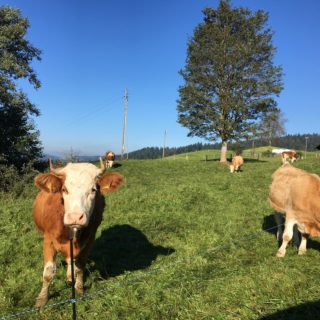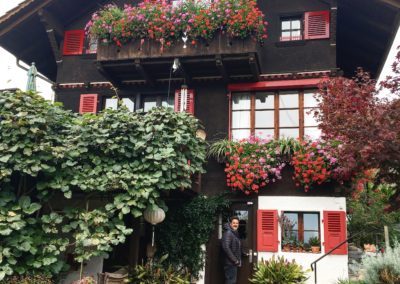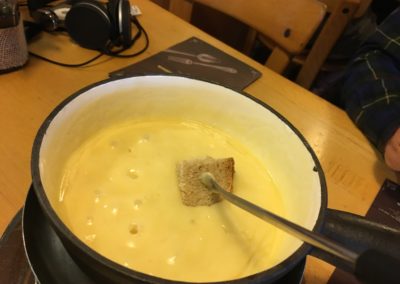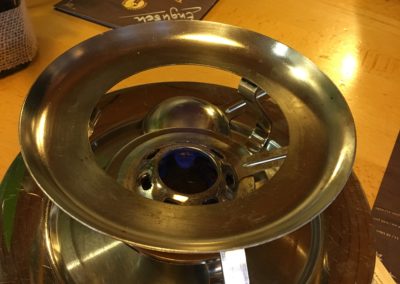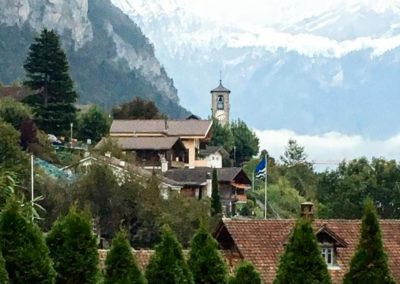Does your Rechaud look like it will never flicker again? Is your Cacqualon collecting dust? Has it been more than three decades since you endulged in a good crusty Religieuse? Why not pull that stuff out of your storage cabinet, give it a good scrubbing, grate up some Tete de Moine, and start dipping. Hi, this is Jeff Baker, this week the Savory road leads to the Alps where hard mountain cheeses lend the perfect texture and flavor for Switzerland’s favorite dish – Fondue.
Based on the French verb Fondre which means “to melt” Fondue first appeared in a 17th century Zurich cookbook which called for grated cheese melted with wine and served with bread. The recipe evolved over the years and by 1930 became Switzerland’s National Dish. It was introduced to us at the Swiss Pavillion’s Alpine Restaurant at the 1964 New York World’s Fair.
Shortly after that, it seemed like every American home had a Fondue set: The earthenware pot (the Cacqualon) … the sturdy frame that housed a small portable heat source – or Rechaud. And the set of lethal looking long-handled forks. The tasty dish was fun to eat as small crowds gathered to submerge bread and vegetables into a communal pot sitting in the middle of a table. Fondue remained popular in American homes over the next ten years. Eventually it proved to be a fad and the kits ended up getting packed away with the 8-track tape players and Earth shoes. A few years ago Fondue resurfaced – mostly offered in restaurants.
On our recent trip to Switzerland, Donna and I had a chance to enjoy traditional, home-made Fondue prepared by locals. We stayed at an AirBnB in Merlagin – a lakeside village located at the base of the Alps near Interlaken. This beautiful setting is the heart of Fondue country and the dish has remained a significant part of the culture all these years. Our hosts Claude and Anna Marie explained why Fondue is still o popular..because they like cheese in Switzerland.
They have great cheese to choose from. Fondue can be made with one cheese or a variety of cheeses. The stuff with holes that we call Swiss cheese they call Ementaller. It’s tasty, but relatively soft for the perfect Fondue consistency, so only a small amout is recommended. Hard cheeses like Gruyere work best. We learned a few simple tricks to making it come out right…
Garlic cloves are cut in half and rubbed into the pot. The garlic oil provides flavor and also lubes the bottom of the pot so later you can enjoy the crusty remnents, or Religieuse. Over low heat, corn starch is stirred into wine to ensure the cheeses will maintain a smooth consistency. The dry white European wines – such as Sauvignon Blanc and Reisling – bring enough tartaric acid to form a stable fondue. The grated cheese is added in small batches and stirred in a figure eight fashion to prevent balling. Before moving the pot to the serving table.
Kirsch – a cherry brandy – lends a delightful tartness to the Fondue. We dipped our bread into small glasses of Kirsch before dunking into the melted cheese. The flavor combination and texture was amazing.
Claud told me that those who lose a piece of bread in the fondue pot must buy the next bottle of wine.
You’ll find the ingredients for authentic Fondue at your local grocery store. If you can’t find Kirsch, use apple or pear brandy.
So what’s happening closer to home?
Check out the Asian-American Expo, one of the largest Asian-themed events in the country. Among the thousand-plus vendors you’ll find three food courts offering a variety of delicious foods from China, Korea, and Southeast Asia. That’s happening at the Pomona fairgrounds this weekend from 10 to 7 each day.
For More information visit us at Savoryroad.com. I’m Jeff Baker

